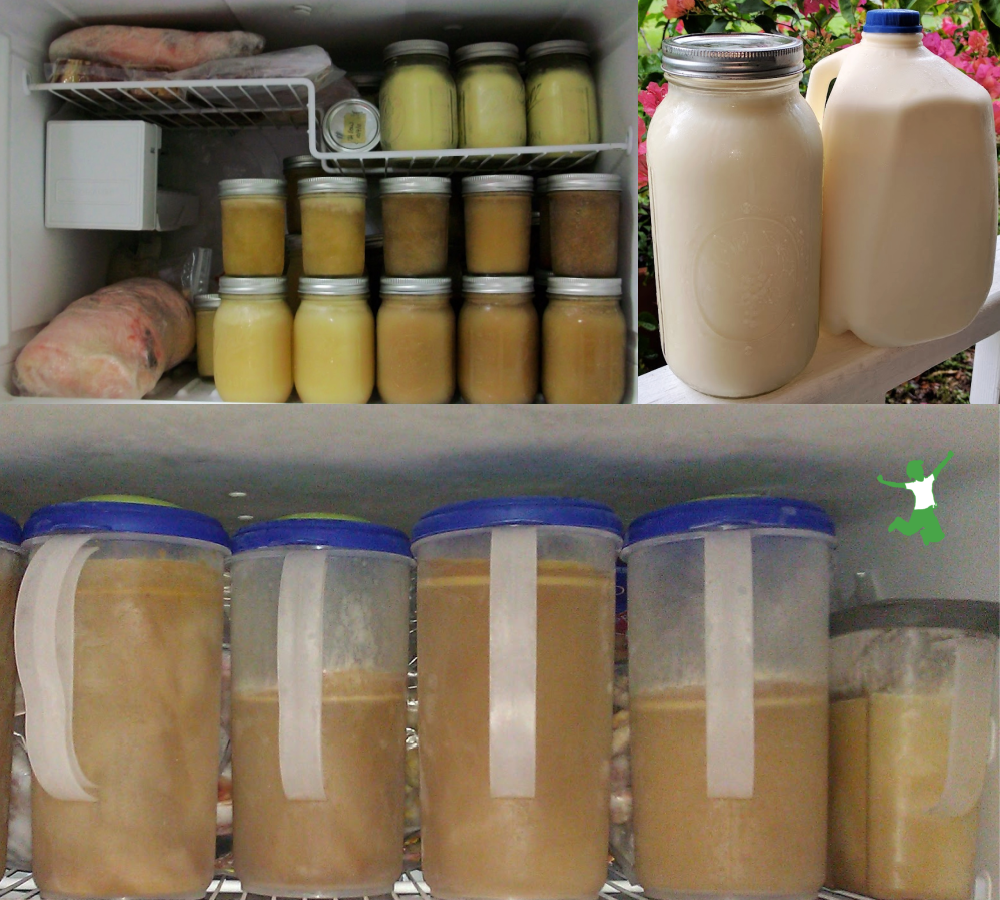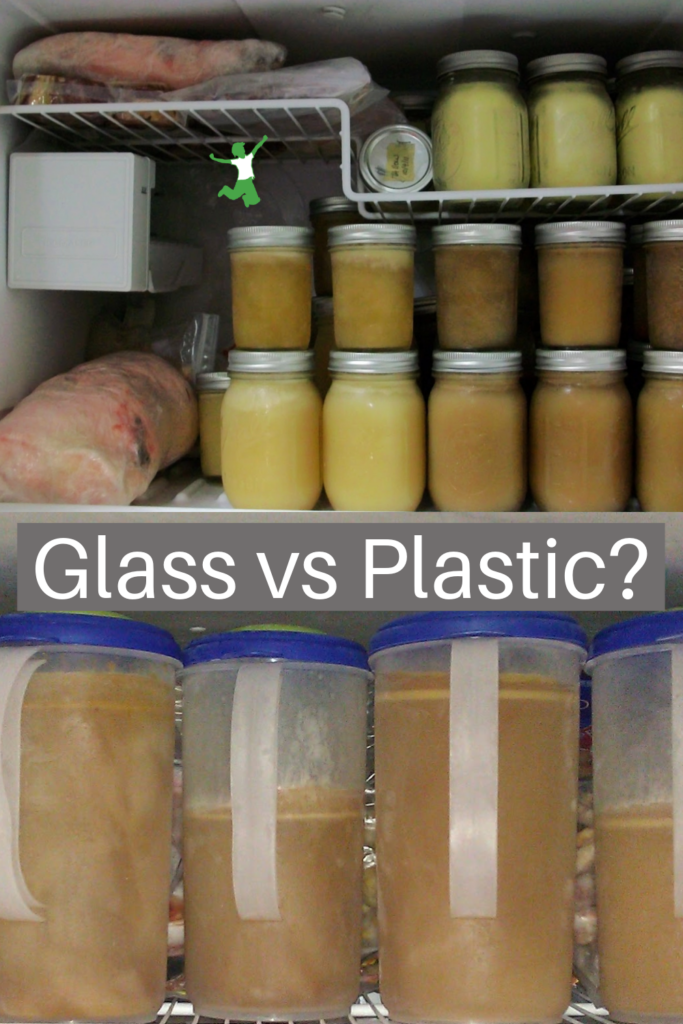Choosing and using the best freezer containers that will keep your food optimally fresh and avoid issues with cracking, leaching, or breakage.

When it comes to freezing raw milk and other traditional foods like bone broth, there are so many types of containers to choose from!
There are certainly pros and cons for both glass and plastic if you examine the issue from both a practical and environmentally-friendly standpoint.
While glass may be the obvious green choice, is it safe to use for freezing especially with young children in the house?
Are the leaching concerns regarding plastic overblown when it comes to frozen foods?
Let’s take a look and see!
Plastic Freezer Containers
The good news is that if you’ve been using plastic for frozen food storage, the practice is probably not leaching chemicals as long as the food is room temperature or colder when it is put in the container.
Cold plastic does not leach chemicals at a rapid rate like heated plastic does.
So, while you should never put hot food or liquids into contact with plastic, storing cold or frozen food is usually safe with high-quality containers (never single-use, old, or scratched plastic).
Caveats to this practice include avoiding storage of acidic liquids (like apple cider vinegar) and foods (tomato sauce) in plastic.
In addition, fatty and oily foods tend to be more prone to sucking chemicals out of plastic compared to dry foods like nuts or flour. (1)
Another downside to plastic versus glass is that the food generally has more issues with freezer burn over time.
Tips for Safe Plastic Use in the Freezer
Here are some other tips from the Environmental Working Group (EWG) for the safe use of plastic for food storage and as freezer containers: (2)
- Don’t microwave food or drinks in plastic containers — even if they claim to be “microwave safe.” Heat can break down plastics and release chemical additives into your food and drink. In addition, microwaves heat unevenly, creating hot spots where the plastic is more likely to get too hot, break down, and release chemicals.
- Use plastic containers for cool or frozen liquids and food only — never hot.
- Don’t reuse single-use plastics. They can break down and release hormone-disrupting chemicals when used repeatedly.
- Avoid old, scratched plastic containers. Exposures to the chemicals in plastic may be greater when the surface is worn down.
- Wash plastic containers by hand with mild dishsoap and only using warm (never hot) water. Keep plastic out of the dishwasher!
If you follow these guidelines for using plastic for freezing, it is a relief to know you are most likely not exposing yourself and your family to hormone-disrupting or forever chemicals.
However, plastic is clearly not as green a choice environmentally speaking as glass for freezer containers.
If you would prefer to up your game with regard to freezer containers and transition to glass, you will be happy to learn that it is possible to use this type of container safely!
As a bonus, you will find that food stored in glass tastes better when it is thawed and used in your favorite recipes!
Using Glass
The key to safe usage of glass for freezing raw dairy and other foods is choosing the right type and size of jars.
Take heart if you’ve had a lot of breakage when attempting to freeze food in glass before. There are several tricks to know about that avoid these problems!
Two things in particular impact the chance of breakage when using a particular glass jar as a freezer container:
- Age
- Shape
Old glass jars will break much more readily than new ones.
Make sure that the glass containers you select for freezing are new or relatively so.
It’s also a good idea to put a plan in place to replace them every so often to avoid breakage.
My rule of thumb is to not use any jars older than a year for the freezer. I use older jars for pantry storage instead.
Jar Shape is Crucial
While the age of the container is important, the shape of the glass container is critical.
Be sure that the glass jars you choose as freezer containers are straight-sided if at all possible.
This is because if there is any narrowing of the container toward the top, the container is more likely to crack during the freezing process.
If you remember from high school chemistry, as liquids containing water freeze, they expand upwards.
This is what gives rise to the tendency of glass to crack if that expansion process is restricted in any way by the container’s shape.
If there is no narrowing of the container during this upward expansion, problems and cracking/breakage are unlikely.
What if a jar curves only at the bottom?
No worries there. The narrowing and curving toward the top of the jar is what matters most when it comes to avoiding breakage.
What If All your Jars Narrow At the Top?
If you have curved jars that narrow toward the top, there is no need to replace them if you want to use them as freezer containers.
Simply leave enough room for expansion so that the frozen liquid won’t go above the narrowed portion of the jar.
Leave the Lid Off Until the Food is Frozen
It is common sense not to fill a glass container to the top with liquid if you intend to freeze it.
Even if a straight-sided jar is used in that case, it will still crack when the expanding liquid encounters a lid.
If you wish to be extra safe to ensure no cracking of a glass jar, I suggest leaving the lid off entirely until the liquid has completely frozen.
Then, gently screw on the lid…but never too tightly.
Waiting until the food/liquid inside the jar is frozen before putting on the lid.
This trick will also extend the life of the jar for freezing purposes.
Safest Method for Freezing Food in Glass
If freezing in glass still makes you nervous even after reviewing the guidelines above, it would be best to stick with commercial canning jars that are labeled as freezer-safe.
Freezer-safe jars (such as these) are not only straight-sided but also have a handy fill line marked right on the jar.
This way, you know exactly how much food or liquid to put in to prevent cracking or breakage.
Buying canning jars labeled as freezer-safe with a maximum fill line etched right on the glass takes all the guesswork out of the process.
These containers permit the use of glass…the greenest and healthiest material for freezer containers – to be used without worry.
BPA-Free Lids
I have one more tip to pass along when choosing and using glass for freezer containers.
Be sure to use jars that come with BPA-free lids.
Metal, screw-on lids that have white plastic on the underside of the lid are not preferable to metal lids that are plain metal on the underside.
Alternatively, you can choose BPA-free plastic lids (such as these) for your glass jars.
In my opinion, however, the plain metal screw-on lids are better because they don’t use any plastic at all.
Do you have any other tips for safe, green freezer containers?
Please share with all of us in the comments section.

(1) Nearly 10,000 chemicals leaching from plastic containers into food, alarming study reveals
(2) Pick Plastics Carefully








Hi Sarah,
I store cooked foods, tomato and courgette sauce from the garden in foil containers with a cardboard lid. Is this a good way to put hot food in and put on the lid, then allow to cool and then freeze? Leaving room for a little growth then you can put in a pot straight from the container and thaw and also thaw in the fridge. Love to know your thoughts…thank you
I personally do not think using aluminum foil is a good idea. https://www.thehealthyhomeeconomist.com/aluminum-foil-alternatives/
I do the same as Julie and don’t screw the lid on tight until the contents are frozen. Then, I do back and tighten. That works for me most of the time….unless I overfill a bit!
I used to try and freeze stock and other foods in glass jars in the freezer and always had breakage. Worse than broken jars was having to throw away my chicken stock and other foods. Tried to find out from everybody why this was happening and didn’t fill the jar up 3 inches from the top and they still broke. Tried putting them in the fridge overnight and they still broke. Finally, read an email about canning and contacted the person who had the email and she sent me a link to another blogger that showed what you are saying was the problem. Using jars with shoulders would break unless you leave the food or stock an inch below the shoulder. Plan to get some 24 oz straight sides jars for my next attempt to freeze in glass as I don’t like using plastic.
I’ve read (can’t remember where) that oils and fats might cause plastics to leach chemicals quicker.). Do you know anything about that?
Thanks
Thanks for these tips for freezer containers. I’m glad you mentioned that you should try to wash plastic containers with mild dish soap. I’m interested to learn if you should only use a small amount of dish soap or if it’s OK to use a lot if it really needs to be cleaned.
A lot is fine if necessary. Just keep the water warm and not hot.
Thanks for sharing this informative post with the readers. I prefer to use glass jars as they are safe to use and doesn’t contain harmful chemicals. But through your post, I got various helpful tips which I would love to share with my friends. Keep sharing such useful tips in future as well.
Storing in glass is one of the best ways to preserve food. Glass will keep seeds and vegetables cooler and drier than plastic and will ensure they don’t get contaminated with industrial polymers.
An added protection in case of breakage is to put each container in a brown paper lunch bag. You can also label these for an easy way to see what you have.
To store milk even longer, I put the glass milk jar inside a small trash can, fill the can with ice or partially ice and water. I put the trash can in the fridge keeping the jar of milk colder at a lower temperature.
Also, most refrigerators have a vent that brings cold air from the freezer circulating into the frig. Place your milk storage right at that vent! It’s usually in the lower half of the frig.
I’ve had quite a few wide mouth screw on lid type quart canning jars break even tho I left over an inch of head space and wondered why this happened? I put the food in the jars and let it cool before putting in the freezer. I now use plastic, but prefer glass.
Hi….I too use the straight sided Ball canning jars with the wide mouth plastic screw-on covers. I freeze COOLED broth, soups, sauces, etc with the jar just barely screwed on. Almost just sitting on top of jar. If the lid is screwed on tight, there is no way to release the pressure from the expanding food product . With the lid “ajar”, pressure from the expanded frozen product freezes without breakage. Then I screw on the lids tight.